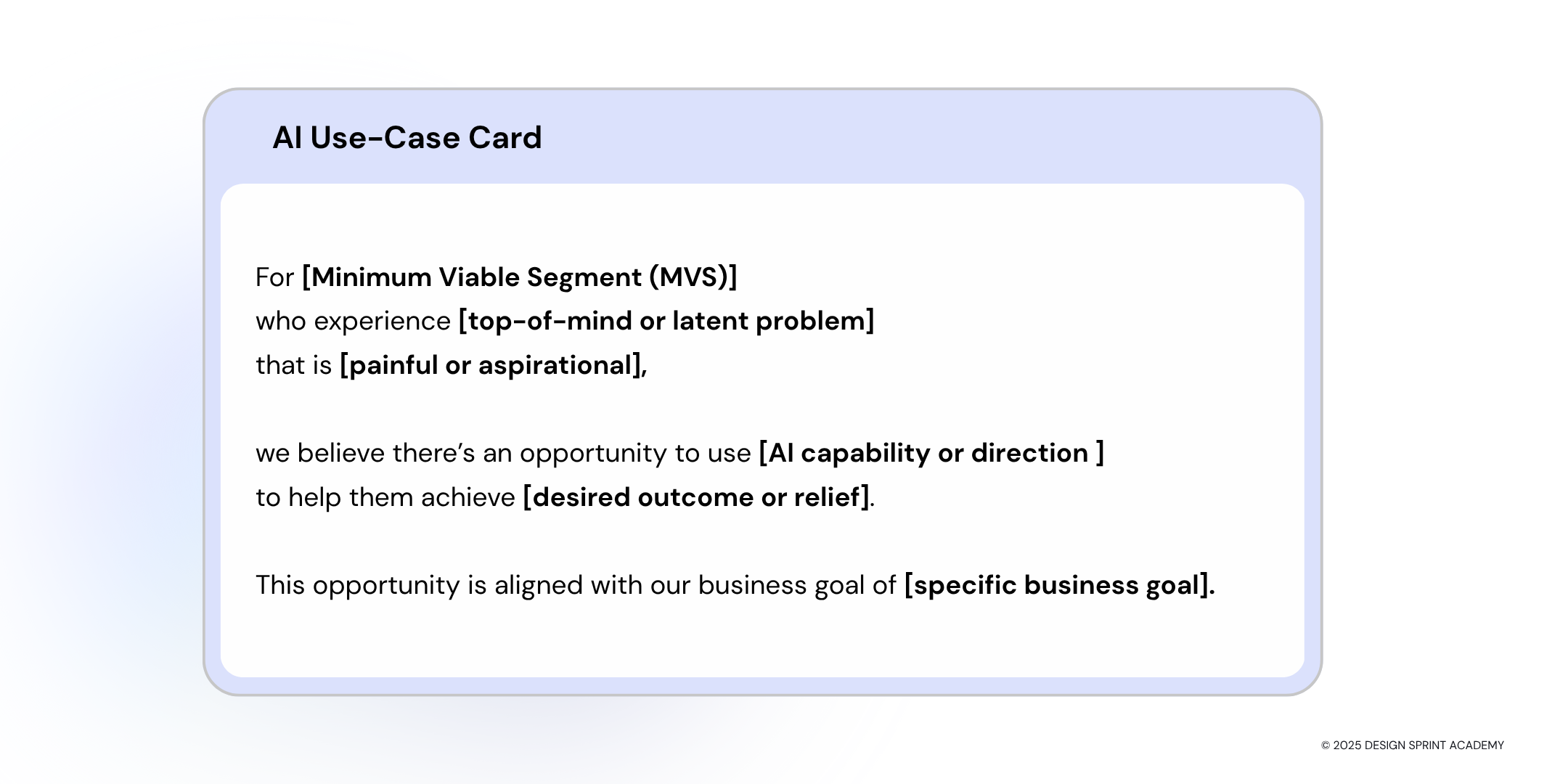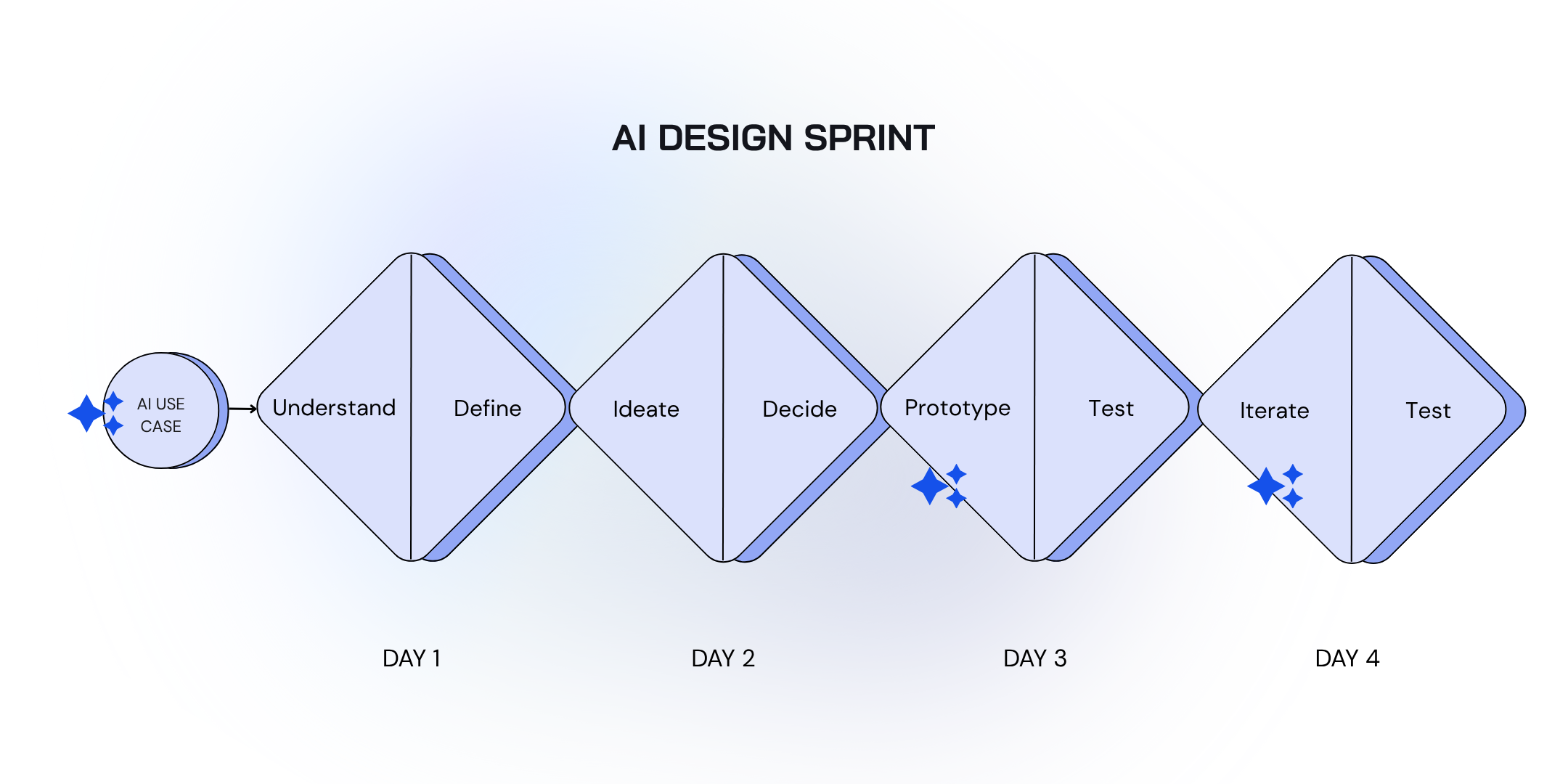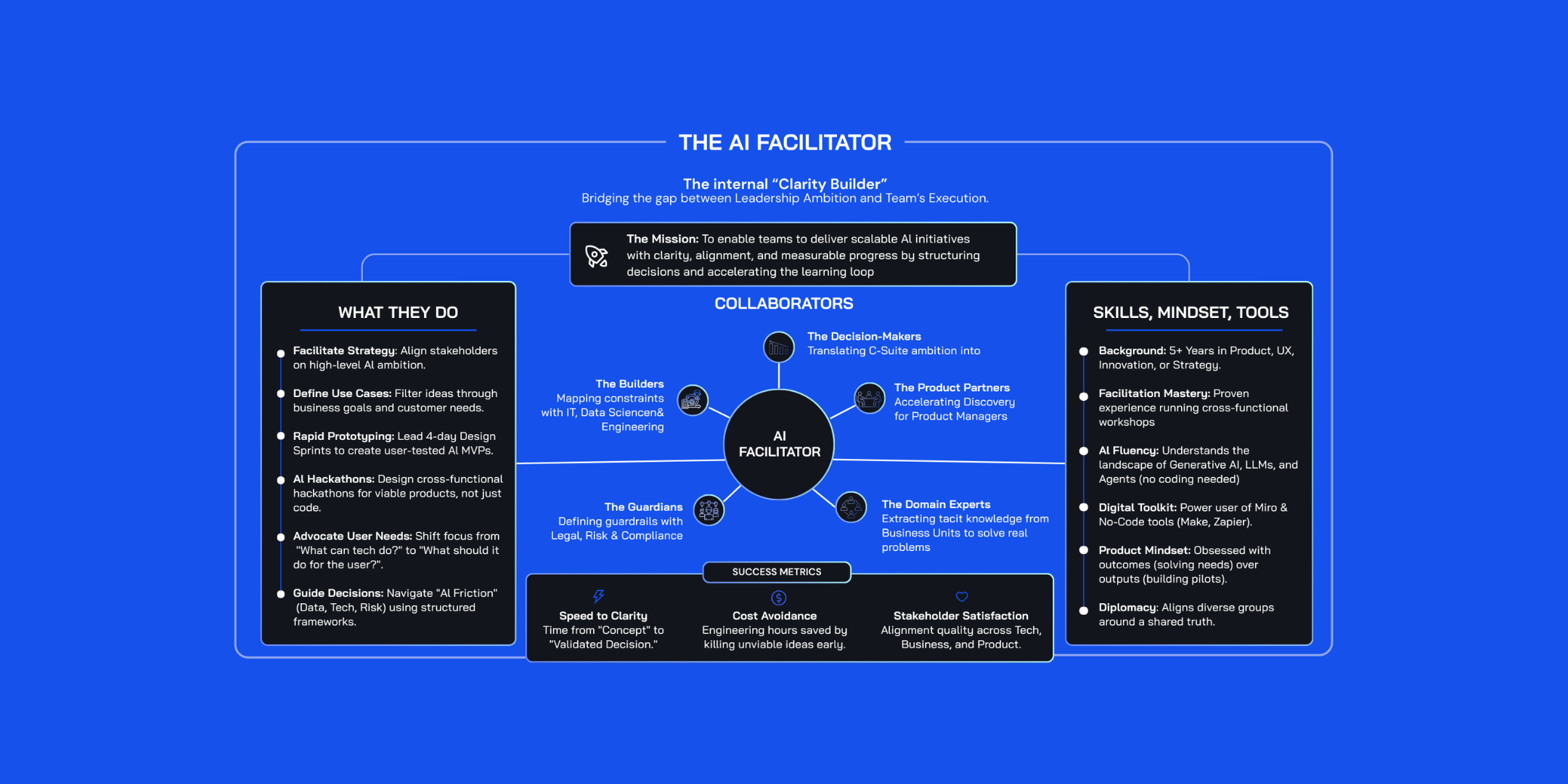What is an AI Design Sprint?

AI adoption is happening... and it is happening fast. “Agentic” systems are on everyone’s lips. Tools are easy to use. Anyone can build anything.
Organizations already have their AI strategies and innovation roadmaps. But now they need people who can turn their AI vision into real, usable products — at scale.
The catch? They’re not just looking for courage, communication, or AI fluency. Not even your proven record of executing big initiatives. What they really want — even if they don’t say it explicitly — is this:
People who can turn vague ideas into the right thing, at scale.
To do that, you need more than tools, knowledge and willpower. You need structured thinking, cross-functional alignment, and a repeatable process that brings the right people into the room at the right time to figure out what to build and why.
That’s where the Design Sprint re-enters the story — and it’s more relevant now than ever.
Let’s rewind: What is a Design Sprint?
A Design Sprint is a fast-paced, structured 4-day process for solving big problems and testing new ideas — through collaboration, prototyping and real user feedback.
It’s not a brainstorming session. It’s not a design-thinking retreat.
It’s a system for:
- Aligning siloed stakeholders fast
- Turning assumptions into hypotheses
- Prototyping quickly
- Testing with real users before committing to months of dev work
The Design Sprint was born at Google and popularized by Jake Knapp — but it was brought to global enterprises by a handful of early pioneers. Design Sprint Academy was one of them — leading the first wave of adoption, co-organizing Google’s Sprints for Change Conference, and training thousands of practitioners inside organizations like SAP, Roche, RGA, The World Bank, HSBC, EY, ELM and many more across industries and cultures.
Over the last decade, design sprints became a global movement — especially among design and innovation teams who needed a fast, human-centered way to explore bold ideas and solve customer problems.
But here’s the missed opportunity: Design Sprints were always meant to be a Product Manager’s best tool.
They were designed for those responsible for turning strategy into execution, delivering new solutions, making big bets and driving real business growth.
So why did PMs leave them behind?
Despite their impact, design sprints became misunderstood:
- Seen as time-consuming and resource-heavy
- Applied to improve features, instead of solving big, complex challenges
- Confused as “just for designers”
- Misapplied without the necessary preparation or facilitation
- Lacked leadership buy-in or were skipped for short-term delivery pressure
PMs kept shipping features. Designers kept iterating. AI arrived. And the design sprint quietly slipped off the radar.
Until now.
Why Design Sprints Are Perfectly Made for the AI Era
Let’s be real: everything about launching AI-powered solutions today mirrors the conditions that led to the invention of the sprint in the first place.
Same issues, bigger stakes.
- Siloed teams, disconnected stakeholders
- New tech with unclear value
- High pressure to move fast
- Uncertainty about what users actually need
And on top of that…
- AI pilots are launched in isolation
- Teams are “doing AI” without a clear understanding of feasibility or usefulness
- Prototypes are built fast — but rarely validated or adopted
- Human-centricity is sacrificed for “what’s possible with AI”
Design Sprints fix this — not by solving everything, but by solving the right thing first.
What AI Design Sprints Do (That AI Teams Need Now)
✅ Surface diverse perspectives and spark aligned decisions
✅ Connect the business, technical, and user lens
✅ Stress-test assumptions before investing in agents, models, or data
✅ Replace back-and-forth debates with evidence
✅ Keep humans in the loop — where it counts most
✅ Build better prototypes — because we ask better questions
Yes, everyone can build faster. But Design Sprints remind us why we’re building in the first place.
A Modern Sprint for Modern Needs
AI Design Sprints aren’t a return to the old way.
They’re a refined version of the sprint methodology, adapted for:
- AI-native products
- Multi-functional teams with different vocabularies
- Tighter constraints
- Ethical, data, and compliance considerations
- A world where “done” is never truly done — and learning is constant
This isn’t just about validating ideas. It’s about building the organizational muscle to think, decide, and act — at speed, together.
We’re not just reviving the Design Sprint.
We’re evolving it — to match the complexity and pace of modern AI teams.
First... Some brutal honesty
We’ve all seen design sprints that looked promising…
❌ Until the problem wasn’t clear.
❌ The real data wasn’t there.
❌ The team wasn’t the right one.
❌ And the workshop facilitation missed the mark.
Even the best methodology falls flat when it’s poorly executed.
That’s why execution quality matters — and so does adapting the structure to today’s needs.
What’s Different in an AI Design Sprint?
We’ve modernized the format to reflect how real AI solutions are developed:
✅ The right team composition
✅ A structured, pre-sprint AI Problem Framing workshop
✅ A sprint flow that integrates feasibility and viability as constraints right from the start
Who’s in the Room?
We recommend a 7–9 person team — small enough for speed, diverse enough for quality decisions. The AI Design Sprint team typically includes:
- Product Manager (Decider) – owns the challenge and the accountability
- AI/ML Engineer – technical feasibility
- Data Scientist – model constraints and data logic
- UX Designer or Researcher – customer lens
- Legal/Compliance Lead – governance, ethics, risk
- Ops or Customer Success – real-world pain and adoption barriers
- Business/Sales - business viability
- Marketing Rep – market needs and message fit
- Facilitator - to guide the team through the process, manage group dynamics and ensure they reach their objective
Before the Sprint: AI Problem Framing
Not every AI idea should go into a design sprint. That’s why we begin with a focused, 1-day workshop to:
- Capture and prioritize AI mandates
- Map them against feasibility, viability, and desirability
- Align on a clear opportunity with leadership buy-in
The output: a validated AI Use Case Card like this:

This clarity becomes the sprint’s north star.
Read more about how to run an AI Problem Framing session in this article: AI Problem Framing 101
The AI Design Sprint: What Happens in 4 Days

Day 1 [Understand & Define]
Objective: Set a shared foundation. Align on the problem, context, and constraints.
- Review your selected AI Use Case from the AI Problem Framing workshop.
- The team deep-dives into constraints:
- Data readiness
- Technical feasibility
- Legal, privacy & ethical risks
- Integration & governance challenges
- User trust concerns
- Map & refine the current user journey or the service blueprint to visualize what’s broken today, where are the friction points, what AI might change?
- Define the goal of your AI solution — and what “success” looks like
🧭 By the end of Day 1: You’ll have a shared understanding of the opportunity, risks, and goals — with all the expertise in the room aligned and ready to ideate.
Day 2 [Ideate & Decide]
Objective: Generate bold ideas — and converge on a high-potential solution.
This is where creativity and expertise collide.
- Everyone generates individual solution sketches — informed by Day 1’s deep understanding.
- Team members use AI tools (like GPTs or creative GenAI tools) to explore variants, simulate flows, or co-design parts of the solution. This unlocks unconventional thinking.
- You then critique, combine, and evolve ideas — balancing ambition with feasibility.
- The team selects a solution concept to prototype: one that delivers user value, is technically feasible, and respects all constraints.
🧭 By the end of Day 2: You have a well-defined concept, rough flow, and consensus on what to prototype and test — plus ideas for how AI will actually power the experience.
Day 3 [Prototype & Test]
Objective: Build a realistic prototype and get early feedback from real users.
Speed meets storytelling.
- The team builds a rapid prototype — not a final product, but a realistic simulation of the user experience.
- This might be a clickable mockup, chatbot flow, AI-generated interface, or simulated assistant.
- Where needed, GenAI tools are used to simulate interactions or create realistic content.
- Prep for user testing: Define key assumptions to validate, create a test plan, and assign observers.
- Test with real users or target stakeholders.
- What do they understand immediately?
- What surprises or confuses them?
- How would they use it? Would they trust it? Pay for it?
🧭 By the end of Day 3: You’ve gathered first-hand feedback on your AI solution from real users — and know where it hits or misses.
Day 4 [Iterate & Test Again]
Objective: Improve fast, validate deeper, and shape the path forward.
This is what most teams skip — but where the real value lies.
- Synthesize Day 3 learnings. What did users really say or think? What patterns emerged?
- Make focused iterations to the prototype — improve clarity, flow, language, or functionality.
- Run another test cycle — with new users or the same ones — to validate refinements.
- Reflect as a team:
- What worked? What still needs attention?
- What do we now know we shouldn’t build?
- What questions remain before implementation?
🧭 By the end of Day 4: You walk away with a sharpened, user-tested AI solution concept — plus confidence in your next steps, and clarity on how to pitch or build it.
By the end of the AI design sprint, your team walks away with:
✅ A validated AI solution concept — tested with real users
✅ A clear build spec — grounded in feasibility and customer value
✅ Shared cross-functional alignment and clarity
✅ Confidence that you’re not just building fast — you’re building right
Why This Matters
AI teams don’t just need more time, or more managing, more skills, or more/better leadership.
They need better systems to work together, make decisions, and build products people actually want to use.
That’s what AI Design Sprints deliver.
Fast, collaborative, human-centered validation — in a world where velocity matters, but clarity matters more.
Don’t build faster. Sprint smarter.


.jpg)
.png)





